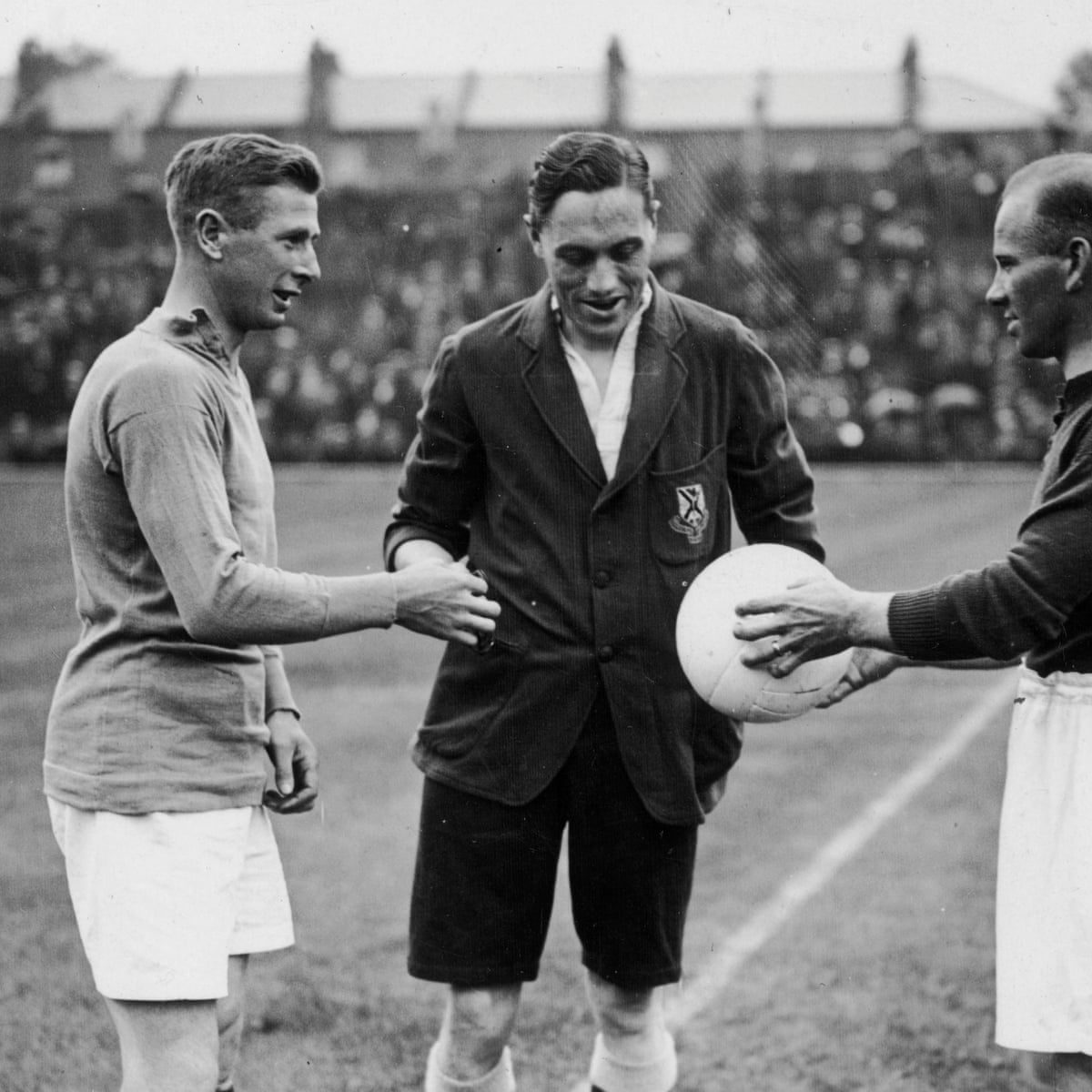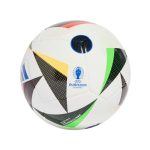Soccer balls are black and white to aid visibility for players and officials during games, especially in low-light conditions. Soccer, also known as football in many parts of the world, is a sport loved and played by millions across the globe.
One distinctive feature of soccer is the black and white color pattern of the iconic soccer ball. But have you ever wondered why soccer balls are black and white? It turns out that there’s a practical reason behind this design choice.
The contrasting black and white colors help enhance visibility for both players and officials during matches, particularly in situations where lighting may not be optimal. This ensures that the ball is easily distinguishable against the green field and makes it easier for players to track its movement. We will explore the reasons behind the choice of black and white soccer balls and delve into how this design aids the sport.
A Brief History Of Soccer Balls
Soccer balls became black and white due to the need for better visibility on the pitch, allowing players to track the ball more easily. This color scheme has been used since the early 20th century and has become an iconic symbol of the sport.
Soccer, also known as football in many parts of the world, is the most popular sport on the planet. And at the heart of this sport lies one of its most iconic symbols – the soccer ball. Over the centuries, soccer balls have undergone significant changes, evolving from simple leather spheres to the meticulously designed and engineered balls we see today. In this article, we’ll delve into the fascinating history of soccer balls, exploring their evolution over the years and the introduction of the distinctive black and white design.Evolution Of Soccer Balls Over The Years
The evolution of soccer balls is a testament to the sport’s ever-changing nature. From its humble beginnings to the modern era, soccer balls have witnessed a remarkable transformation. Here’s a glimpse into the key stages of this evolution: 1. Leather Balls: In the early years of soccer, the balls were made from animal bladders covered in leather. These primitive balls were not very durable and often soaked up water, making them heavy and unpredictable during games. 2. Rubber Bladders: In the late 19th century, rubber bladders were introduced, replacing the animal bladders. This innovation led to improved durability and better ball control, making the game more enjoyable and consistent. 3. Plastic Coating: As technology advanced, synthetic materials were incorporated into soccer ball manufacturing. A plastic coating was added to the exterior, increasing resistance to wear and tear and enhancing ball longevity. 4. Modern Manufacturing Techniques: Today, soccer balls are produced using cutting-edge manufacturing techniques. Multiple layers of synthetic materials, such as polyurethane or synthetic leather, are stitched together to create a durable and highly responsive ball. These advancements ensure optimal performance and control for players, regardless of the playing conditions.Introduction Of Contrasting Colors: The Black And White Design
The iconic black and white design of modern soccer balls is not just a matter of aesthetics. This distinctive color scheme serves a functional purpose, enhancing visibility and making the ball easier to track during games. The contrasting colors create a strong visual contrast against a green playing field, helping players and spectators alike to follow the ball’s movement. The concept of using contrasting colors on soccer balls can be traced back to the 1970 FIFA World Cup. The Adidas Telstar, the official match ball of that tournament, introduced the revolutionary black and white panel design. The bold pattern, featuring 32 hexagonal and 12 pentagonal panels, became an instant hit and continues to be an iconic symbol of the sport. Since then, the black and white color combination has become a staple in the world of soccer balls. Manufacturers have experimented with different variations of the design, incorporating innovative textures and patterns that not only enhance visibility but also improve the ball’s aerodynamics and overall performance. In conclusion, the humble soccer ball has come a long way since its early days as a simple leather sphere. The constant evolution and innovation in ball design have contributed to the advancement of the game itself. Today, the black and white design remains a timeless representation of soccer, captivating fans around the globe and symbolizing the unity, thrill, and beauty of the beautiful game.
Credit: www.amazon.com
The Significance Of Black And White Colors In Soccer Balls
When you think of a soccer ball, the iconic black and white pattern immediately comes to mind. But have you ever wondered why soccer balls are black and white? The answer lies in the significance of these colors, both in terms of symbolism and cultural importance, as well as their practical purpose in enhancing visibility and tracking during games.
Symbolism And Cultural Significance Of Black And White
The black and white colors on soccer balls carry deep symbolism and cultural meaning. The contrasting colors represent the duality and unity that exists in the beautiful game of soccer. Black symbolizes strength, power, and determination, while white represents purity, fairness, and clarity of intentions.
Furthermore, the black and white pattern is reminiscent of the ancient yin and yang symbol, which signifies balance and harmony. This connection to duality resonates with soccer, a sport that brings together individuals from different backgrounds and cultures, promoting teamwork, camaraderie, and equitable play.
Contrast For Better Visibility And Tracking During Games
The black and white design of soccer balls serves a practical purpose on the pitch. The high-contrast colors create excellent visibility, making it easier for players, officials, and spectators to track the ball’s movement during fast-paced games. The sharp contrast between the black pentagons and white hexagons allows players to judge the direction, speed, and spin of the ball accurately.
Additionally, the black and white pattern enables players to perceive depth and distance better, especially when the ball is in the air. The contrast helps players anticipate the trajectory and timing of headers, volleys, and passes, facilitating quick decision-making on the field.
The visibility provided by the black and white design also benefits referees and linesmen, allowing them to make accurate judgments during matches. From deciding if the ball has crossed the goal line to determining offside positions, the high contrast aids officials in making fair and impartial decisions in crucial moments.
In conclusion, the black and white colors hold symbolic and cultural significance in soccer and contribute to the practical aspects of the game. The contrasting pattern not only represents unity and balance, but also enhances visibility and tracking, allowing players, officials, and fans to fully engage in the thrilling world of soccer.
The Influence Of Television And Mass Media
In the world of sports, soccer holds a special place. With its global popularity, it’s no wonder that the game has been greatly influenced by television and mass media. This influence is particularly evident in the design of soccer balls, where the choice of colors and patterns has been carefully considered to cater to the demands of televised matches. In this blog post, we will explore the impact of television broadcasting on the design of soccer balls, as well as the importance of visibility and contrast on screen.
Impact Of Television Broadcasting On Soccer Balls’ Design
Television broadcasting has played a crucial role in shaping the appearance of soccer balls. As matches started to be televised, it became evident that the traditional solid-colored balls used in the early days of the sport were not suitable for the medium. The lack of contrast made it difficult for viewers to track the ball’s movement on screen, leading to a less enjoyable viewing experience.
To address this issue, soccer ball manufacturers began experimenting with different patterns and colors. One of the most successful designs to emerge was the black and white paneling that we are so familiar with today. This pattern provides a stark contrast that makes it easier for viewers to see the ball, even from a distance or at high speeds. The alternating black and white panels create a visual effect known as the “strobe effect,” where the ball appears to flicker, enhancing its visibility on television.
Importance Of Visibility And Contrast On Screen
Visibility and contrast are essential factors in ensuring an enjoyable viewing experience for televised soccer matches. With millions of viewers tuning in from various devices and screen sizes, it is crucial that the soccer ball stands out and can be easily tracked. The black and white color scheme used in soccer balls today has proven to be highly effective in achieving this objective.
When the ball is in motion, the black and white panels create a stark contrast against the green grass of the field. This strong contrast helps the ball to stand out prominently, making it easier for viewers to follow its trajectory and anticipate its movements. It also allows the camera operators to track the ball easily, ensuring that important moments are captured and showcased to the audience.
Moreover, the black and white design is not only effective on television screens but also translates well in other formats such as print media and online platforms. Its high contrast and distinct appearance make it instantly recognizable, further enhancing the branding and visibility of soccer as a sport.
In conclusion, the influence of television and mass media on the design of soccer balls cannot be underestimated. The black and white paneling we see today is the result of careful consideration of visibility and contrast on screen. By using bold patterns and colors that create a stark contrast, soccer ball manufacturers have successfully catered to the demands of television broadcasting, ultimately enhancing the viewing experience for soccer fans around the world.The Science Behind Black And White Soccer Balls
Soccer balls are traditionally black and white due to their visibility on the green field. The contrasting colors help players track the ball’s movement and make it easier for referees to make decisions in fast-paced games. The design is based on scientific research and practical considerations for the sport.
Soccer, also known as football, is undoubtedly one of the most beloved and widely played sports across the globe. From grassroots to professional levels, players rely on their skills and strategies to outperform their opponents. However, have you ever wondered why soccer balls are predominantly black and white? The answer lies in the science behind it. Let’s delve deeper into the visual perception and contrasting colors used in soccer balls to understand their significance and how they impact the game.
Visual Perception And How The Human Eye Processes Colors
Our eyes, marvelous organs that they are, play a crucial role in helping us perceive the world around us. When it comes to soccer, visual perception plays a significant part in players’ ability to track the ball and make accurate passes or shots. The human eye consists of specialized cells called cones, responsible for perceiving color. These cones are particularly sensitive to three primary colors: red, green, and blue.
The black and white color scheme of soccer balls offers a purposeful advantage. By eliminating distracting colors, it allows players to focus on the ball’s movement quickly. The contrast between the black and white panels also makes it easier for the cones in our eyes to identify the ball’s position and distinguish it from the background. This sharp contrast improves depth perception and enhances the overall tracking ability, enabling players to react effectively during fast-paced gameplay.
Contrasting Colors For Better Depth Perception And Tracking
Contrasting colors have a profound impact on an individual’s depth perception. In the game of soccer, where speed and accuracy are crucial, the black and white panels on the soccer ball offer a visual advantage. The difference in color intensity between the panels creates distinct depth cues for players. This means that when the ball is in motion, the alternating black and white panels facilitate depth perception, making it easier for players to judge the ball’s location and anticipate its trajectory.
Moreover, the distinctive appearance of black and white soccer balls supports effective tracking. When a player kicks the ball, the contrasting colors create an optical flicker effect, aiding in swift ball tracking. This visual phenomenon helps players maintain focus amidst a crowded field, allowing them to react swiftly to the ball’s movements and make accurate decisions on the pitch.
In conclusion, the black and white color scheme of soccer balls might seem simple at first glance, but its significance lies in the science behind visual perception and contrasting colors. By capitalizing on the human eye’s ability to process colors and leveraging contrasting colors for better depth perception and tracking, the black and white soccer ball enhances gameplay and ensures a thrilling experience for players and spectators alike.
The Evolution Of Soccer Ball Designs
The evolution of soccer ball designs has seen remarkable changes over the years. From the early days of soccer to the modern game we know today, soccer balls have undergone various innovations in design and materials. These changes have not only enhanced the performance of the ball but also added aesthetic appeal to the game. Let’s take a closer look at the key innovations in soccer ball design and materials and the modern variations of soccer balls and their color schemes.
Innovations In Soccer Ball Design And Materials
In the early days of soccer, soccer balls were far from the standardized design we see today. The first soccer balls were made using materials like leather, cloth, and animal bladders. These balls were not very durable and had inconsistent flight characteristics. However, as the game evolved and grew in popularity, manufacturers began experimenting with different materials and designs to improve the performance of soccer balls.
One major innovation in soccer ball design was the introduction of an inner tube made of rubber. This provided better shape retention and improved the bounce of the ball. Furthermore, the development of synthetic materials like polyurethane and PVC revolutionized soccer ball technology. These materials offered greater durability, water resistance, and consistent flight.
Another remarkable innovation was the introduction of the 32-panel design. This design, first used in the iconic Adidas Telstar ball in the 1970 World Cup, featured 32 hexagon and pentagon-shaped panels stitched together. The 32-panel design improved ball control and increased the accuracy of passes and shots.
The introduction of foam cushioning systems in soccer balls also had a significant impact on the game. Foam cushioning provided players with better control and reduced the impact on their feet when making a hard kick. This innovation not only increased player comfort but also improved overall performance.
Modern Variations Of Soccer Balls And Their Color Schemes
In addition to advancements in design and materials, modern soccer balls have also undergone changes in their color schemes. Traditionally, soccer balls were predominantly black and white, which provided high visibility and contrast on the field. The distinctive black and white pattern also helped players gauge the spin and trajectory of the ball.
However, with advancements in technology and the demand for visually appealing designs, soccer balls now come in a variety of colors and patterns. Manufacturers have introduced colorful designs, including vibrant hues and intricate patterns, catering to different preferences and styles. These modern variations not only bring excitement and uniqueness to the game but also offer improved visibility under different weather conditions.
While the black and white color scheme remains the most popular and traditional choice, soccer balls today can be found in a range of colors, including red, blue, green, and even multi-colored designs. These variations allow players to express their individuality and add a touch of personality to their game.
Frequently Asked Questions On Why Are Soccer Balls Black And White
Why Are Soccer Balls Black And White?
Soccer balls are black and white to provide better visibility and contrast on the field. The contrasting colors help players judge the ball’s movement and make accurate passes. Additionally, the black and white pattern helps referees and spectators track the ball’s trajectory during a game.
Conclusion
Soccer balls are black and white due to their visibility and contrast on the field. The contrasting colors help players easily track the ball’s movement during intense gameplay. Additionally, the black and white design aligns with traditional soccer aesthetics and allows for better visual recognition for both players and spectators.
So, next time you kick a soccer ball, remember the significance of its black and white pattern on the beautiful game.

General Manager & Auditorial Head.
Killian Jake is a World Sports Traveler and hobbyist sports lover. By exploring different sorts of playing modules like indoor, outdoor, and many more. As for professionalism and writing, it’s helpful to give you the right suggestions on different games and sports.





